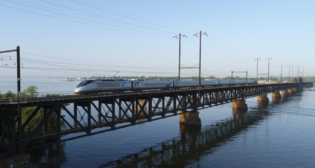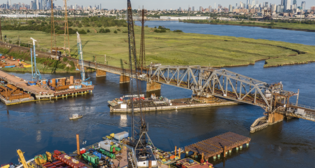
Railroading in a post-9/11 world
Written by William C. Vantuono, Editor-in-ChiefThe recent 10th anniversary of 9/11 gave us all pause to think about those tragic events and reflect on whether life is different today because of them. On Sept. 12, 2001, national security and protecting America became the new priority for our society. Across all spectrums people got on with the task of addressing homeland security.
The railroad industry was no different, and began to adapt within hours of the attacks. Railroad history in the United States is nearly as old as the country itself, dating back to the mid-1820s. Through good times and bad, our railroads have been part of the cultural fabric of our country. We, as an industry, have reacted and responded to adversity for almost 200 years, and after 9/11, the railroad industry responded quickly, immediately tightening security and intensifying inspections. Access was restricted to facilities and full service restored as quickly as possible in hard-hit areas. A liaison was also immediately established with the FBI for intelligence sharing and coordination. Within days, the railroads had assembled some 600 professionals engaged in security tasks ranging from cyber issues to military mobility. Within 90 days a cross- section of this group had developed and implemented a comprehensive railroad industry security plan that remains in effect today as the “new normal.”
Within the past 10 years, the Department of Homeland Security and the Transportation Security Administration (TSA) were created as regulatory bodies of the federal government. Both agencies have oversight with railroads in a number of evolving areas. In 2006, as TSA was defining its mission with various sectors and modes, the rail industry stepped forward and agreed to 27 voluntary security action items. TSA uses these action items to evaluate freight rail security performance and improvement on a quarterly basis. Since these measurements have been enacted, our nation’s railroads have shown continuous improvement.
New initiatives, terms, and acronyms have become part of the daily routine and lexicon of North America’s railroads. In the private sector, two of the most significant are the establishment of the Railroad Alert Network (RAN) and the creation of the Surface Transportation Information Sharing and Analysis Center (STISAC). The RAN is a secure 24/7 center for the reporting and dissemination of key security related information for all freight and passenger railroads engaged in national commerce. The STISAC handles issues related to detecting and defending against cyber, or information technology threats to railroads. Other private-sector “new normal” actions include daily security briefings, security awareness training, community first responder training and coordination to mitigate vulnerability/protect assets, new tank car designs, and industry committees addressing physical and cyber security.
Since 9/11, the railroads also have been dealing with the feds in a number of new ways. Each railroad has a designated primary and secondary Rail Security Coordinator (RSC) for dealing with the TSA. Chain-of-custody and routing rules now govern the handling of dangerous goods. Corporate Security Reviews (CSR) and corridor assessments are routinely conducted on the nation’s railroads. The reduction of dwell time in High Threat Urban Areas (HTUAs) is an ongoing collaboration between freight railroads and TSA.
Freight railroads have invested $2 billion on security since 2001 in areas ranging from company ID cards to infrared intrusion detection. Add to that passenger rail investments and government spending, and the number grows to tens of billions of dollars. The need to balance security with the industry’s ability to provide commerce is always a foremost consideration in any action undertaken. In many areas, railroads have been able to work with customers to enact security measures and improve service at the same time. Cooperation and coordination with communities and local law enforcement authorities have also improved.
Are we safer today than we were 10 years ago? There are many visual reminders: bomb sniffing dogs, police with automatic weapons, electronic alerts on highway message boards, and of course the new routines at every airport. In my opinion, yes, we are safer today.
Has 9/11 changed our lives? It’s true that many things are new, but at the same time, most noticeable is how life hasn’t changed. Even when events rock the world, our resilience and character as Americans bring us back to our time-tried values. Maybe that’s the biggest takeaway; it’s not so much that things have gone back to “normal.” It’s more that we have accepted our new normal with all of its security measures and continue to live our lives. Railroads and railroading are a part of this “can do” American attitude. Security is the latest challenge, but railroaders will be ready to meet the next challenge, as they have been for the past 19 decades.
Stephen Sullivan is Vice President and Executive Director of the American Short Line & Regional Railroad Asssociation.



